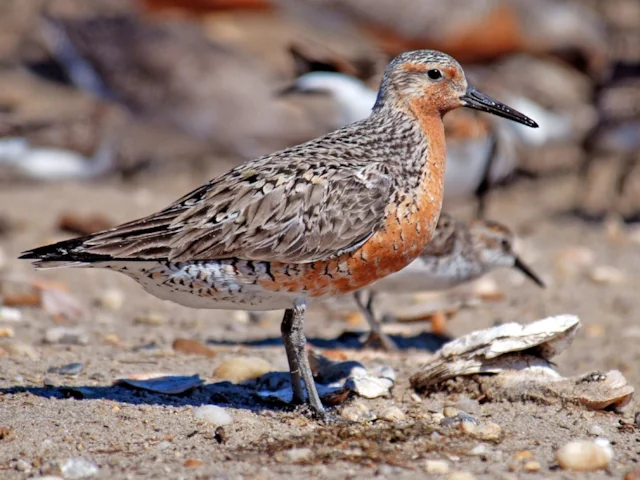Knot under threat in America
568d4ecb-47ac-4b60-a0fc-933ca22ba9f3

Despite remaining common in Europe, Knot is about to be declared a Threatened species for the first time in North America.
A little over a month ago, the US Fish and Wildlife Service (USFWS) proposed to list 'Red Knot' (of the north American subspecies rufa) as Threatened under the Endangered Species Act in the United States. The adoption of this status would provide additional protection measures for the species, along with increased funding dedicated to the recovery of Red Knot populations.
This important step marks more than a decade's effort of warning and focused advocacy on behalf of the subspecies. Since 2005, there have been four formal requests to list Red Knot under the Endangered Species Act but citing a lack of resources and other priorities, the USFWS opted not to list the species but placed it in the functional limbo of "candidate species" in 2006 instead.
The USFWS noted that a primary factor in the recent decline of Red Knot on the eastern seaboard has been reduced food supply in Delaware Bay resulting from over-harvesting of Horseshoe Crabs. The ability of Red Knots and other shorebirds to refuel and fatten up on Horseshoe Crab eggs during migratory stop-overs is critical to their survival during their journey from South America to their Arctic breeding grounds.
The wader's population decline has been most dramatic since 2000. Scientists speculate that the species' breeding grounds in the Arctic have warmed, feeding areas on Delaware Bay, Cape Cod, and elsewhere have been impacted by rising sea levels and ocean acidification, and increasing temperatures have interfered with their lifecycles. For example, Horseshoe Crabs in Delaware Bay may be laying their eggs earlier than usual, thus leaving the migratory shorebirds with a shortfall when they reach this critical stop-over site.
Although Threatened status is different from Endangered status, such a move could require states to adopt better regulatory mechanisms to limit Horseshoe Crab harvest, or the USFWS could additionally designate crucial protected habitat for the shorebird, such as sand spits for roosting or habitat areas which support prey.
A little over a month ago, the US Fish and Wildlife Service (USFWS) proposed to list 'Red Knot' (of the north American subspecies rufa) as Threatened under the Endangered Species Act in the United States. The adoption of this status would provide additional protection measures for the species, along with increased funding dedicated to the recovery of Red Knot populations.
This important step marks more than a decade's effort of warning and focused advocacy on behalf of the subspecies. Since 2005, there have been four formal requests to list Red Knot under the Endangered Species Act but citing a lack of resources and other priorities, the USFWS opted not to list the species but placed it in the functional limbo of "candidate species" in 2006 instead.
The USFWS noted that a primary factor in the recent decline of Red Knot on the eastern seaboard has been reduced food supply in Delaware Bay resulting from over-harvesting of Horseshoe Crabs. The ability of Red Knots and other shorebirds to refuel and fatten up on Horseshoe Crab eggs during migratory stop-overs is critical to their survival during their journey from South America to their Arctic breeding grounds.
The wader's population decline has been most dramatic since 2000. Scientists speculate that the species' breeding grounds in the Arctic have warmed, feeding areas on Delaware Bay, Cape Cod, and elsewhere have been impacted by rising sea levels and ocean acidification, and increasing temperatures have interfered with their lifecycles. For example, Horseshoe Crabs in Delaware Bay may be laying their eggs earlier than usual, thus leaving the migratory shorebirds with a shortfall when they reach this critical stop-over site.
Although Threatened status is different from Endangered status, such a move could require states to adopt better regulatory mechanisms to limit Horseshoe Crab harvest, or the USFWS could additionally designate crucial protected habitat for the shorebird, such as sand spits for roosting or habitat areas which support prey.

